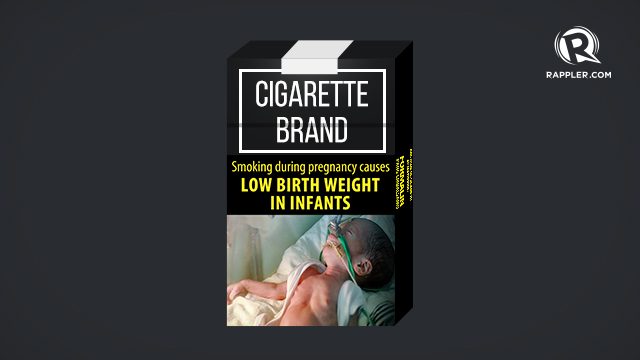SUMMARY
This is AI generated summarization, which may have errors. For context, always refer to the full article.

This compilation was migrated from our archives
Visit the archived version to read the full article.
MANILA, Philippines – This time next year, expect to see cigarette packs with bolder graphic health warnings (GHWs) on the dangers of smoking.
Health Spokesperson Lyndon Lee Suy confirmed to Rappler that the Department of Health has issued the guidelines and the 12 templates for the new cigarette packs on Wednesday, November 5.
Cigarette manufacturers are mandated by Republic Act 10643 to comply with the new packaging rules one year after the issuance of the templates.
The new cigarette packs, anti-smoking advocates say, will discourage young teenagers from taking up the habit.
“The law is actually primarily intended for children who are considering to start smoking,” said Ma Encarnita Limpin, head of the Framework Convention Alliance for Tobacco Control in the Philippines (FCAP).
A year after the full implementation of the law, FCAP is expecting an increase in the number of young Filipino non-smokers.
The visual warnings, however, may not be enough for smokers to quit cold turkey.
Templates
Following the new GHW templates, half of the front portion of the new cigarette packs will include images of a diseased mouth, a bedridden and suffering lung cancer patient, or an innocent little child inhaling second hand smoke. (READ: Look, mate, scary cigarette packs)
The initial set of templates will be valid for two years from implementation. The DOH is also expected to produce a new set of templates next year for the following batch of GHW templates.
Mockup packaging rendered by Jessica Lazaro/Rappler. Graphic Health Warning Templates provided by DOH’s National Center for Health Promotion
Tobacco companies are also expected to rotate the use of the 12 templates periodically for each brand and variant.
Under the law, “no part of the warning may be obliterated, obscured, folded, severed or become unreadable when the tobacco package is opened or closed or when a wrapper on the package is removed.”
The violations and the corresponding penalties are the following:
- On the first offense, a fine of not more than P500,000.00
- On the second offense, a fine of not more than P1 million
- On the third offense, a fine of not more than P2 million or imprisonment of not more than 5 years, or both, at the discretion of the court: Provided, That the business permits and licenses, in the case of a business entity or establishment shall be revoked or cancelled
Countries
In the Philippines, 240 Filipinos die every day due to tobacco-related diseases, according to the World Health Organization (WHO). Worldwide, more than 5 million people die each year as a result of direct tobacco use.
Advocates say the use of graphic health warnings on cigarette packs is garnering growing global support, and is backed by some cigarette companies.
President Benigno Aquino III signed the Graphic Health Warning law in July 2014, years after the bill got stalled in Congress.

The Cigarette Package Health Warnings: International Status Report showed that the number of countries with GHWs increased from 34 in 2010, to 55 in 2012, and to 77 in 2014. The countries that are compelling tobacco companies to include graphic warnings on cigarette packs account for 49% of the world’s population.
Thailand has the world’s largest GHWs, covering 85% of the front and back of cigarette packs. Australia’s GHWs come second with an average of 82.5% (75% front and 90% back) coverage of the cigarette pack. This is in addition to requiring plain or standardized packaging which was implemented since 2012.
The WHO’s Framework Convention on Tobacco Control calls for the implementation of visual health warnings on all tobacco product packaging and labeling.
Tobacco and cigarette companies in the Philippines – such as Philip Morris Fortune Tobacco Corporation Incorporated (PMFTC), Japan Tobacco International (JTI), British-American Tobacco Philippines (BAT), and Mighty Corporation Incorporated (MCI) – are also supportive of the GHWs.
“Graphic health warnings are really a cost-effective measure in curbing smoking especially with those who are just thinking about giving it a try, and I’m ecstatic everybody has caught on the so-called trend,” said Emer Rojas, Global Cancer Ambassador and president of the New Vois Association of the Philippines. – with reports from Jee Geronimo/Rappler.com
Add a comment
How does this make you feel?
There are no comments yet. Add your comment to start the conversation.